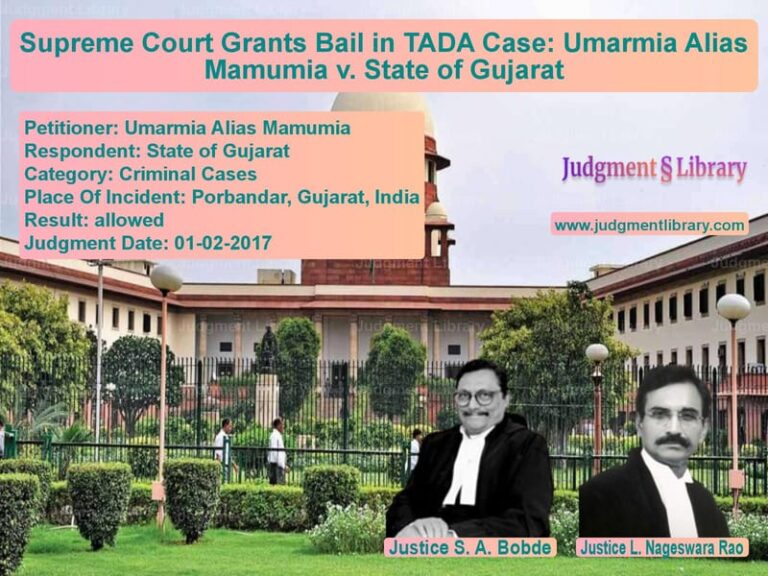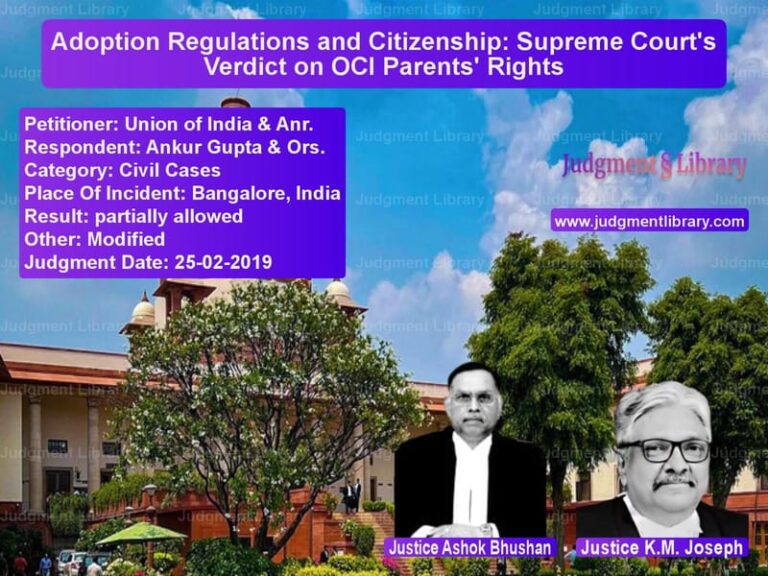Criminal Liability in Attempt to Murder Cases: Supreme Court Ruling in Chhanga @ Manoj v. State of M.P.
Introduction
The case of Chhanga @ Manoj v. State of Madhya Pradesh concerns the criminal liability of an accused charged under Section 307 read with Section 34 of the Indian Penal Code (IPC). The Supreme Court examined whether the conviction of the appellant, despite not actively throwing a bomb, was justified based on his role in inciting the crime.
Background of the Case
The appellant, Chhanga @ Manoj, along with three other accused, was convicted under Section 307 IPC for attempting to murder one Gyan Singh. The prosecution alleged that the accused had a long-standing enmity with Gyan Singh, which led them to plan an attack.
On the day of the incident, the informant, PW1 Man Singh, was sitting in a betel shop when the accused, along with his accomplices, arrived. One of the accused, Rakesh, threw a bomb towards the informant, which exploded, causing injuries to his left thigh. Another bomb was thrown, which exploded upon hitting the window of the shop.
The prosecution argued that the appellant, Chhanga @ Manoj, did not physically throw the bomb but instigated the act by shouting:
“Kill him, he should not be spared, he habitually reports.”
Based on this role in encouraging the attack, the appellant was convicted under Section 307 read with Section 34 IPC and sentenced to three years’ imprisonment by the Additional Sessions Judge. The conviction was upheld by the Madhya Pradesh High Court.
Legal Issues Raised
- Does verbal instigation constitute common intention under Section 34 IPC?
- Was the charge under Section 307 IPC justified despite the injuries being simple?
- Should the appellant be granted leniency in sentencing?
Arguments by the Appellant (Chhanga @ Manoj)
- The appellant did not throw the bomb and was merely present at the scene.
- Injuries sustained by the victim were not grievous, indicating a lack of intent to kill.
- The appellant had already served almost two years in jail, and further incarceration would be unjust.
Arguments by the Respondents (State of Madhya Pradesh)
- The appellant’s verbal instigation showed clear intent and common intention with the other accused.
- The use of lethal weapons (bombs) demonstrated an intent to cause death.
- The appellant was convicted based on eyewitness testimony and had already received a lenient sentence.
Supreme Court’s Judgment
The Supreme Court upheld the conviction and rejected the appeal. The Court reasoned that:
“It is not essential that bodily injury capable of causing death should have been inflicted in order that the charge under Section 307 IPC be made out.”
The Court further emphasized:
“The intention to kill can be inferred from the nature of the weapon used, the words spoken by the accused, and the circumstances of the attack.”
Addressing the appellant’s argument for leniency, the Court observed:
“The crime committed is heinous in nature, and undue sympathy leading to a lesser sentence would undermine public confidence in the efficacy of law.”
Accordingly, the Supreme Court dismissed the appeal and directed the appellant to surrender within two weeks to serve the remaining sentence.
Analysis of the Judgment
This ruling reinforces several legal principles:
- Verbal instigation can establish common intention under Section 34 IPC.
- Attempt to murder does not require actual death but an intent to cause death.
- Severity of injury is not the sole determinant in Section 307 cases.
- Judicial discretion in sentencing should not favor undue leniency in heinous crimes.
Key Takeaways from the Judgment
- Verbal incitement can be as culpable as the physical act.
- Attempt to murder can be proved even if the victim survives with minor injuries.
- Use of deadly weapons like bombs indicates intent to kill.
- Appellate courts will not interfere in well-reasoned concurrent findings.
Implications of the Judgment
This ruling will influence similar criminal cases:
- Encouraging judicial consistency: Lower courts must align with the Supreme Court’s view on common intention.
- Strengthening prosecution of violent crimes: Criminals cannot escape liability by arguing they did not physically harm the victim.
- Guiding sentencing decisions: Courts will be cautious in reducing sentences for violent offenses.
Conclusion
The Supreme Court’s judgment in Chhanga @ Manoj v. State of M.P. upholds the principle that verbal instigation is sufficient to establish liability under Section 307 read with Section 34 IPC. The ruling ensures that those who encourage violent crimes face the same consequences as those who physically execute them.
Don’t miss out on the full details! Download the complete judgment in PDF format below and gain valuable insights instantly!
Download Judgment: Chhanga @ Manoj vs State of Madhya Prad Supreme Court of India Judgment Dated 28-02-2017.pdf
Direct Downlaod Judgment: Direct downlaod this Judgment
See all petitions in Attempt to Murder Cases
See all petitions in Bail and Anticipatory Bail
See all petitions in Judgment by Rohinton Fali Nariman
See all petitions in Judgment by Mohan M. Shantanagoudar
See all petitions in dismissed
See all petitions in supreme court of India judgments February 2017
See all petitions in 2017 judgments
See all posts in Criminal Cases Category
See all allowed petitions in Criminal Cases Category
See all Dismissed petitions in Criminal Cases Category
See all partially allowed petitions in Criminal Cases Category







